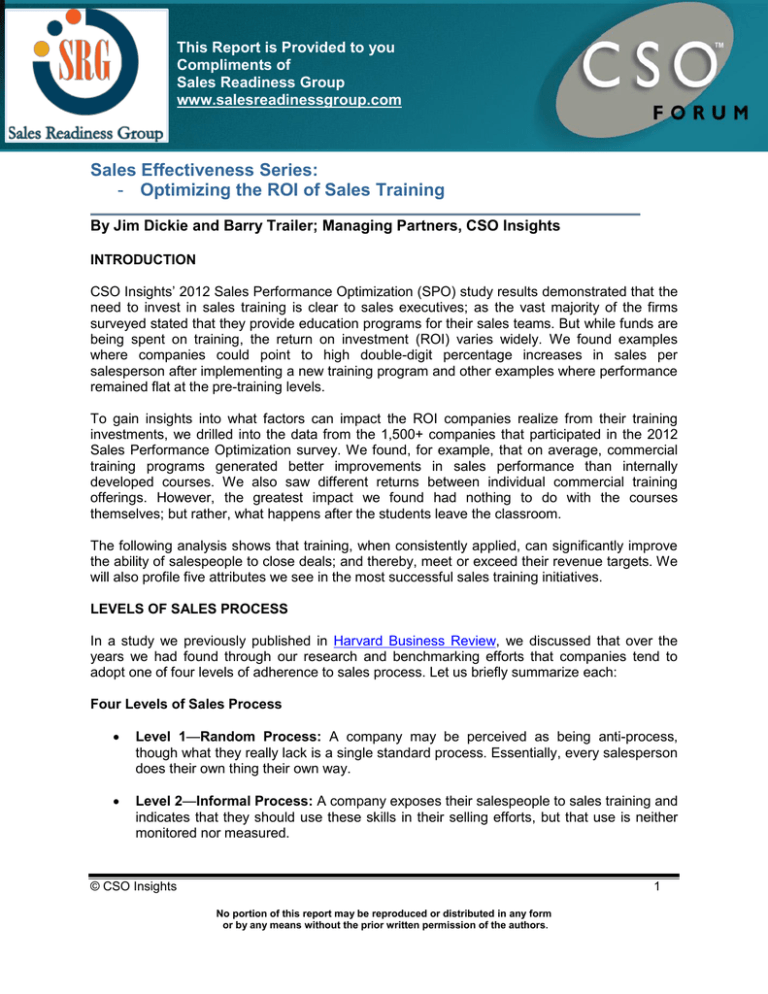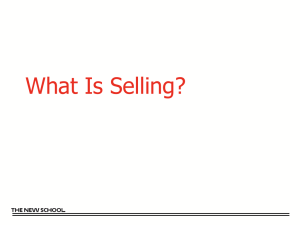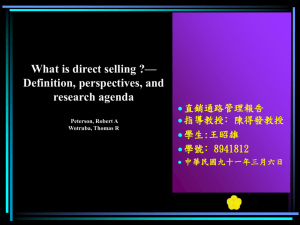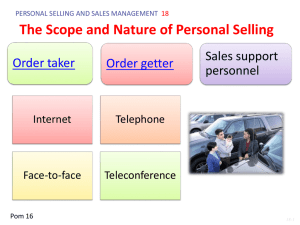Optimizing the ROI of Sales Training
advertisement

This Report Optimizing is Providedthe toROI youof Sales Training Compliments of Sales Readiness Group www.salesreadinessgroup.com Sales Effectiveness Series: - Optimizing the ROI of Sales Training By Jim Dickie and Barry Trailer; Managing Partners, CSO Insights INTRODUCTION CSO Insights’ 2012 Sales Performance Optimization (SPO) study results demonstrated that the need to invest in sales training is clear to sales executives; as the vast majority of the firms surveyed stated that they provide education programs for their sales teams. But while funds are being spent on training, the return on investment (ROI) varies widely. We found examples where companies could point to high double-digit percentage increases in sales per salesperson after implementing a new training program and other examples where performance remained flat at the pre-training levels. To gain insights into what factors can impact the ROI companies realize from their training investments, we drilled into the data from the 1,500+ companies that participated in the 2012 Sales Performance Optimization survey. We found, for example, that on average, commercial training programs generated better improvements in sales performance than internally developed courses. We also saw different returns between individual commercial training offerings. However, the greatest impact we found had nothing to do with the courses themselves; but rather, what happens after the students leave the classroom. The following analysis shows that training, when consistently applied, can significantly improve the ability of salespeople to close deals; and thereby, meet or exceed their revenue targets. We will also profile five attributes we see in the most successful sales training initiatives. LEVELS OF SALES PROCESS In a study we previously published in Harvard Business Review, we discussed that over the years we had found through our research and benchmarking efforts that companies tend to adopt one of four levels of adherence to sales process. Let us briefly summarize each: Four Levels of Sales Process Level 1—Random Process: A company may be perceived as being anti-process, though what they really lack is a single standard process. Essentially, every salesperson does their own thing their own way. Level 2—Informal Process: A company exposes their salespeople to sales training and indicates that they should use these skills in their selling efforts, but that use is neither monitored nor measured. © CSO Insights 1 No portion of this report may be reproduced or distributed in any form or by any means without the prior written permission of the authors. Optimizing the ROI of Sales Training Level 3—Formal Process: A company not only provides training, but also regularly reinforces the use of defined sales skills (sometimes religiously). They conduct periodic reviews of the process to see how effective it is, and then make changes based on that analysis. Level 4—Dynamic Process: A company dynamically monitors and provides continuous feedback on salespeople’s application of prescribed sales skills. They also proactively modify the process when they detect key changes in market conditions. In the original Harvard Business Review study, we found that as companies migrated up the sales process ladder, sales performance improved. We were curious to see if this trend was still holding, so we did an analysis of the 2012 Sales Performance Optimization study data based on the level of sales process a company was currently performing at. Let us share with you those findings and also what we saw as the main reason behind the differences in sales results being achieved between these four groups. SALES PERFORMANCE BASED ON LEVEL OF SALES PROCESS In starting to assess sales performance, the first figure we look at is the percentage of salespeople who are meeting or achieving sales targets. The following graph summarizes the results from the study data. We see that as sales reps move from Level 1 to 2, and 2 to 3, the percentage of salespeople achieving their quotas increases, and then jumps significantly when they move from Level 3 to 4. In looking to see what was contributing to this higher degree of sales success, we drilled further into the data and compared the outcome of forecast deals between these four groups. The following table shows the results of that analysis. © CSO Insights 2 No portion of this report may be reproduced or distributed in any form or by any means without the prior written permission of the authors. Optimizing the ROI of Sales Training Sales Performance Based on Sales Process Level Level 1 Random Process Level 2 Informal Process Level 3 Formal Process Level 4 Dynamic Process % Wins 42.7% 46.4% 50.4% 56.2% % Losses 35.6% 30.3% 27.8% 24.4% % No Decisions 21.7% 23.3% 21.8% 19.4% The interesting trend is that as companies get more focused on sales process, the win rate of forecast deals increases. The main contributor to this improvement in performance is that competitive losses decrease. And we also see that when companies get to level 4, the rate of no decisions start to go down as well. We looked at one other set of metrics that helps point to why sales results improve based on the level of sales process. The last table we will share shows the percentage of salespeople that are actively using the sales skills they have been taught consistently as they pursue new deals. Sales Performance Based on Sales Process Level Level 1 Random Process Level 2 Informal Process Level 3 Formal Process Level 4 Dynamic Process Sales Skills Adoption by >90% of Reps 0% 6.9% 18.4% 61.6% Sales Skills Adoption by >75 - 90% of Reps 0% 18.5% 34.5% 23.2% 0% 25.4% 52.9% 84.8% Total At Level 1 there are not any companies reporting sales skills process adoption rates because there is no process to adopt in the first place. But as salespeople move to Levels 2, 3, and 4, we see that the percentage of companies reporting that at least 75% of their salespeople are consistently/regularly using their sales process, sales skills adoption rates go from 25.4% to 52.9% to 84.8%. The findings point to the high value of ensuring that salespeople consistently apply skills after they learn them. Conducting training without a post-course strategy for how to reinforce and enforce the sales process will significantly reduce the ROI companies generate from their training investments. ATTRIBUTES OF LEVEL 4 TRAINING PROGRAMS In benchmarking Level 4 firms, specifically in regards to their sales training initiatives, we found five characteristics that are common to these sales organizations. © CSO Insights 3 No portion of this report may be reproduced or distributed in any form or by any means without the prior written permission of the authors. Optimizing the ROI of Sales Training Sales Goals/Training Alignment: First, we see that training is directly aligned to the company’s sales goals. For example, if the firm is focused on closing new accounts then training skills courses on prospecting are a priority. If avoiding discounting is a key objective, then education is provided on selling value. Or, if the emphasis for the year is penetrating existing accounts more deeply, then the focus for training could be on crossselling/up-selling. The key point is that training is related to clear business objectives that have an ROI associated with them from day one. Training Customization: Second, because these companies want the skills taught to become part of a salesperson’s daily workflow, the courses are adapted to fit the company versus expecting the company to adapt to fit the courses. This makes it easier for reps to understand and see the value of what they are being asked to learn. Focus on Selling Skills: Third, while product training will always be needed, Level 4 companies realize that prospects typically conduct significant online research before meeting with a salesperson, and, as a result, are no longer reliant on the salesperson for information. So, the primary focus of these companies’ training initiatives is on improving the selling skills of their salespeople, so that they can have meaningful business dialogues with prospects. . Manager/Rep Coaching Commitment: Fourth, in addition to training salespeople on how to use the skills, managers are also trained on how to reinforce them through effective sales coaching. Once the initial training sessions are completed, managers provide their salespeople with ongoing sales coaching in order to ensure that they are applying the new sales skills on the job. Virtual Reinforcement Support: Finally, these sales organizations are leveraging the power of technology to cost-effectively provide virtual reinforcement to salespeople and managers. Anytime, anywhere, reps and managers can access Internet-based courses and tools to review training concepts. SUMMARY With the rapid rate of change that sales teams are experiencing each day; new product lines, enhancements to existing offerings, changes in the competitive landscape, higher customer expectations, etc., continuing to invest in sales training is not an option— but a must! The key is to ensure that the funds that are invested ultimately help move the revenue dial. The 2012 Sales Performance Optimization study data show that the more companies can bring science to the art of selling, the more effective reps will be at closing deals. The findings also illustrate that if you are going to invest in training, then serious thought needs to be given to how to make those new sales skills stick once the salespeople go back to selling. To optimize your training efforts, compare what you are doing to the five attributes discussed above. If one or more of these is missing from your training efforts, then make it a priority to fix it. The size of the prize is significant if you do, and the cost of doing nothing is far too high to be ignored. © CSO Insights 4 No portion of this report may be reproduced or distributed in any form or by any means without the prior written permission of the authors. Optimizing the ROI of Sales Training Comments or questions on this analysis may be directed to: Jim Dickie Barry Trailer (303) 521 4410 (916) 712 9621 jim.dickie@csoinsights.com barry.trailer@csoinsights.com About CSO Insights CSO Insights has provided executives with best practices in sales and marketing for over eighteen years. Each year, we survey thousands of Chief Sales Officers (CSOs) to benchmark the use of people, process, technology, and knowledge, and the impact on sales effectiveness. We also review offerings from solution providers to retain our position as the experts on options for CSOs. We offer pragmatic suggestions, experienced-based examples, and the kind of insights you'll want before your next Executive Strategy Session or Board meeting. Use These Links for More Information from CSO Insights Newsletter Benchmarks Research Reports Solution Finder eBooks Our Current Survey © CSO Insights 5 No portion of this report may be reproduced or distributed in any form or by any means without the prior written permission of the authors.







